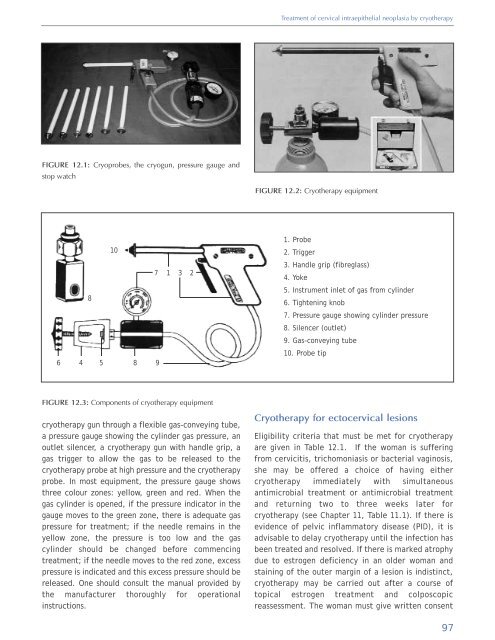Colposcopy and Treatment of Cervical Intraepithelial Neoplasia - RHO
Colposcopy and Treatment of Cervical Intraepithelial Neoplasia - RHO
Colposcopy and Treatment of Cervical Intraepithelial Neoplasia - RHO
Create successful ePaper yourself
Turn your PDF publications into a flip-book with our unique Google optimized e-Paper software.
<strong>Treatment</strong> <strong>of</strong> cervical intraepithelial neoplasia by cryotherapy<br />
FIGURE 12.1: Cryoprobes, the cryogun, pressure gauge <strong>and</strong><br />
stop watch<br />
FIGURE 12.2: Cryotherapy equipment<br />
10<br />
1. Probe<br />
2. Trigger<br />
3. H<strong>and</strong>le grip (fibreglass)<br />
4. Yoke<br />
5. Instrument inlet <strong>of</strong> gas from cylinder<br />
6. Tightening knob<br />
7. Pressure gauge showing cylinder pressure<br />
8. Silencer (outlet)<br />
9. Gas-conveying tube<br />
10. Probe tip<br />
7<br />
1 3 2<br />
8<br />
6<br />
4<br />
5<br />
8<br />
9<br />
FIGURE 12.3: Components <strong>of</strong> cryotherapy equipment<br />
cryotherapy gun through a flexible gas-conveying tube,<br />
a pressure gauge showing the cylinder gas pressure, an<br />
outlet silencer, a cryotherapy gun with h<strong>and</strong>le grip, a<br />
gas trigger to allow the gas to be released to the<br />
cryotherapy probe at high pressure <strong>and</strong> the cryotherapy<br />
probe. In most equipment, the pressure gauge shows<br />
three colour zones: yellow, green <strong>and</strong> red. When the<br />
gas cylinder is opened, if the pressure indicator in the<br />
gauge moves to the green zone, there is adequate gas<br />
pressure for treatment; if the needle remains in the<br />
yellow zone, the pressure is too low <strong>and</strong> the gas<br />
cylinder should be changed before commencing<br />
treatment; if the needle moves to the red zone, excess<br />
pressure is indicated <strong>and</strong> this excess pressure should be<br />
released. One should consult the manual provided by<br />
the manufacturer thoroughly for operational<br />
instructions.<br />
Cryotherapy for ectocervical lesions<br />
Eligibility criteria that must be met for cryotherapy<br />
are given in Table 12.1. If the woman is suffering<br />
from cervicitis, trichomoniasis or bacterial vaginosis,<br />
she may be <strong>of</strong>fered a choice <strong>of</strong> having either<br />
cryotherapy immediately with simultaneous<br />
antimicrobial treatment or antimicrobial treatment<br />
<strong>and</strong> returning two to three weeks later for<br />
cryotherapy (see Chapter 11, Table 11.1). If there is<br />
evidence <strong>of</strong> pelvic inflammatory disease (PID), it is<br />
advisable to delay cryotherapy until the infection has<br />
been treated <strong>and</strong> resolved. If there is marked atrophy<br />
due to estrogen deficiency in an older woman <strong>and</strong><br />
staining <strong>of</strong> the outer margin <strong>of</strong> a lesion is indistinct,<br />
cryotherapy may be carried out after a course <strong>of</strong><br />
topical estrogen treatment <strong>and</strong> colposcopic<br />
reassessment. The woman must give written consent<br />
97
















